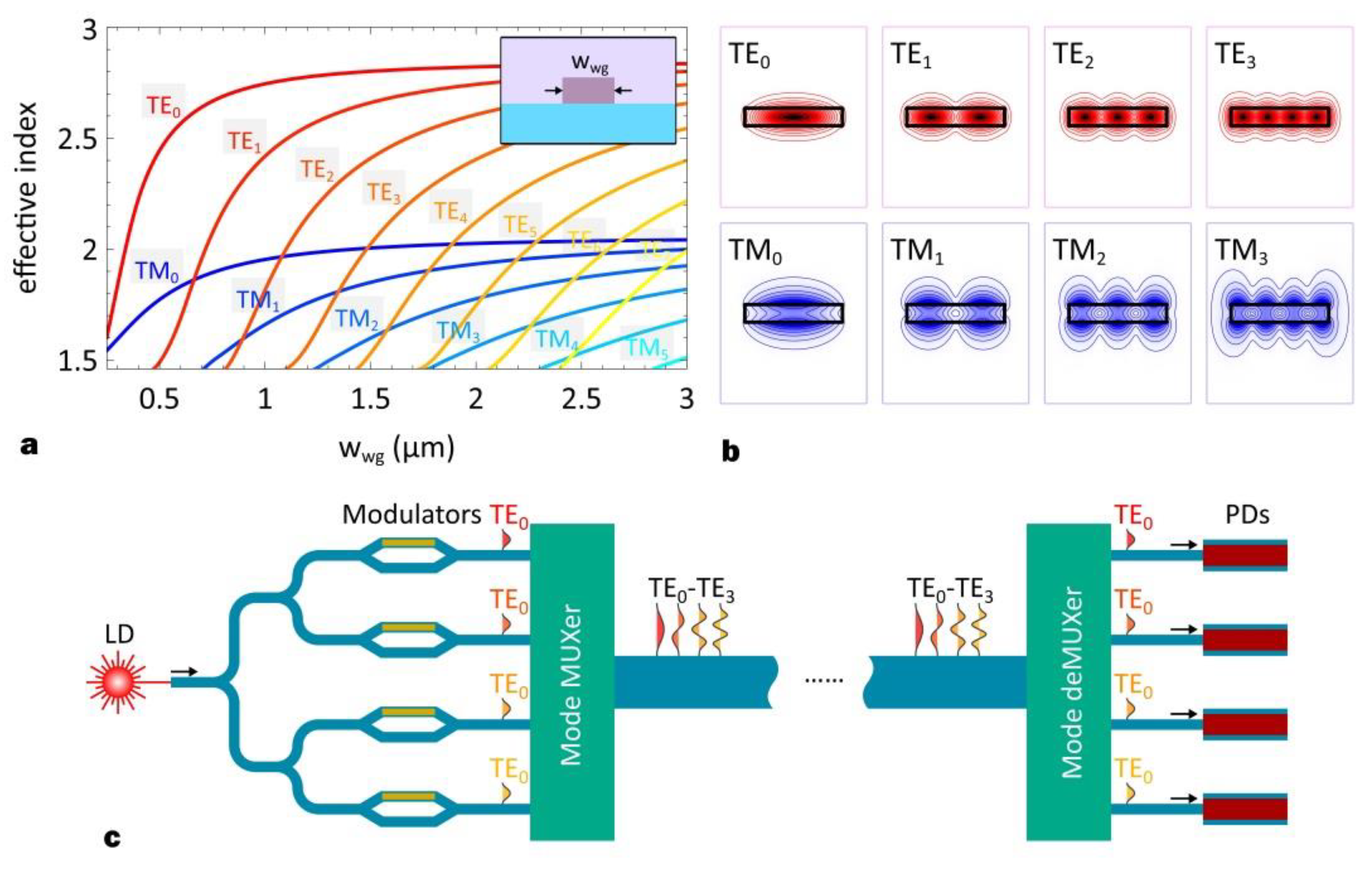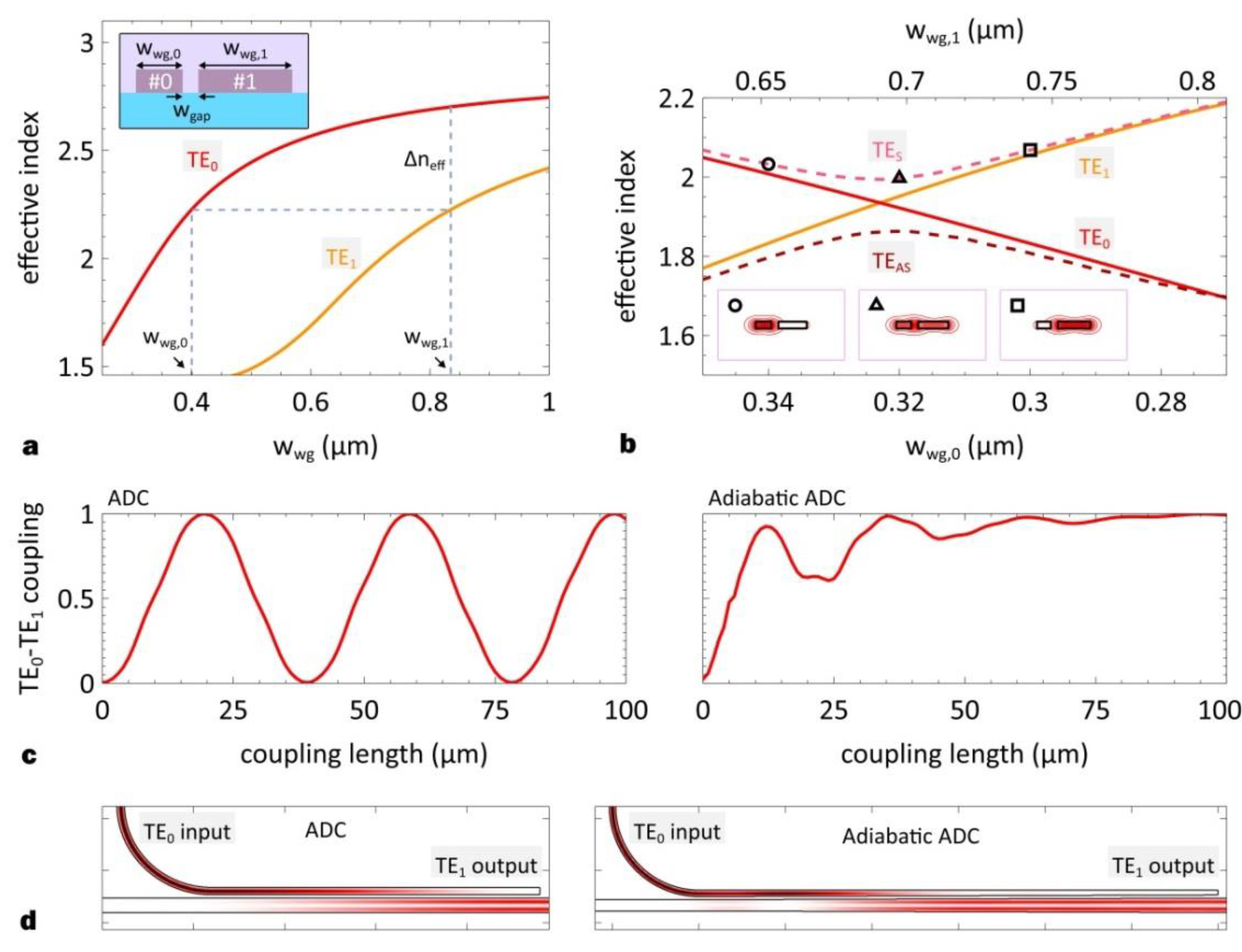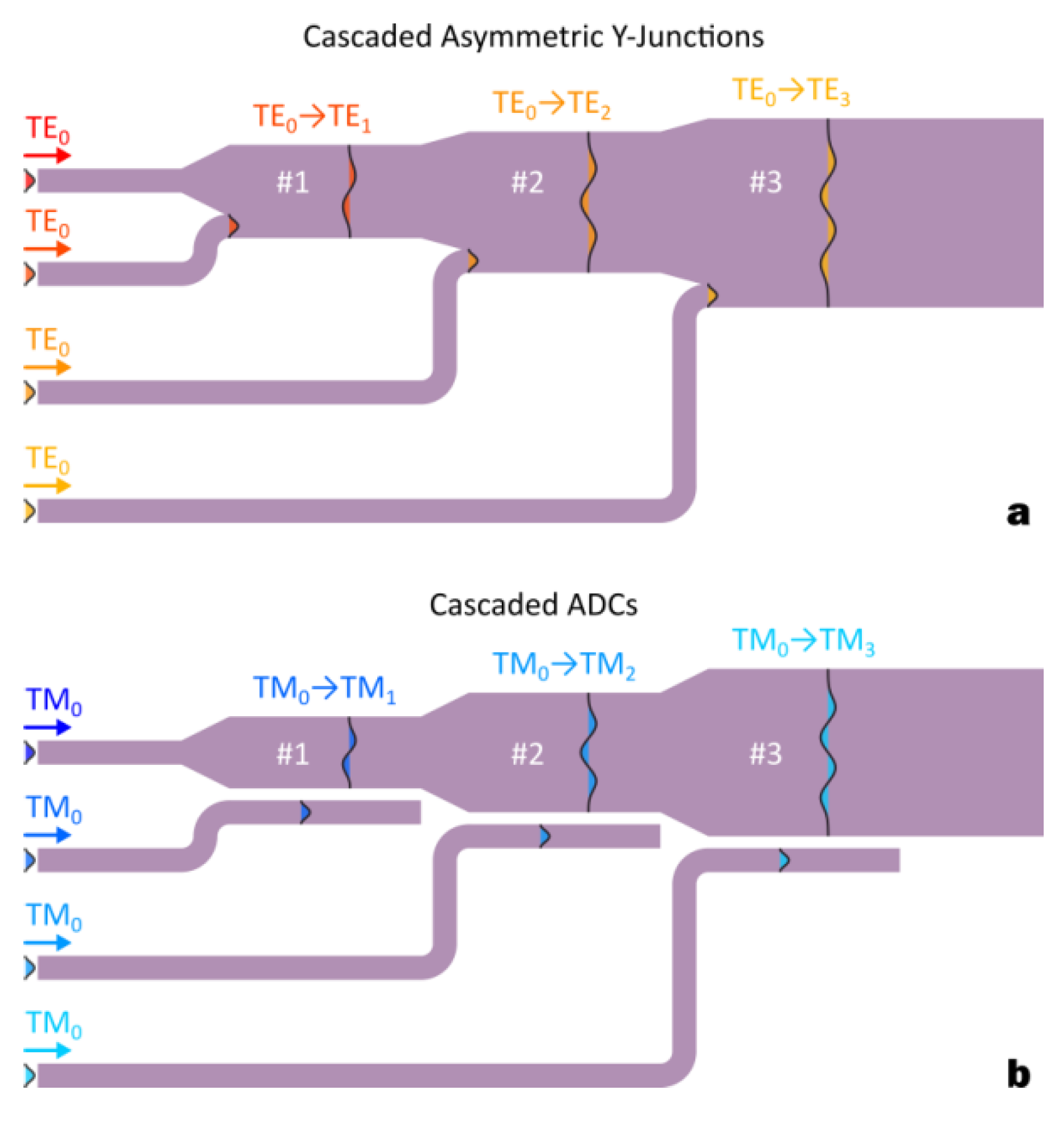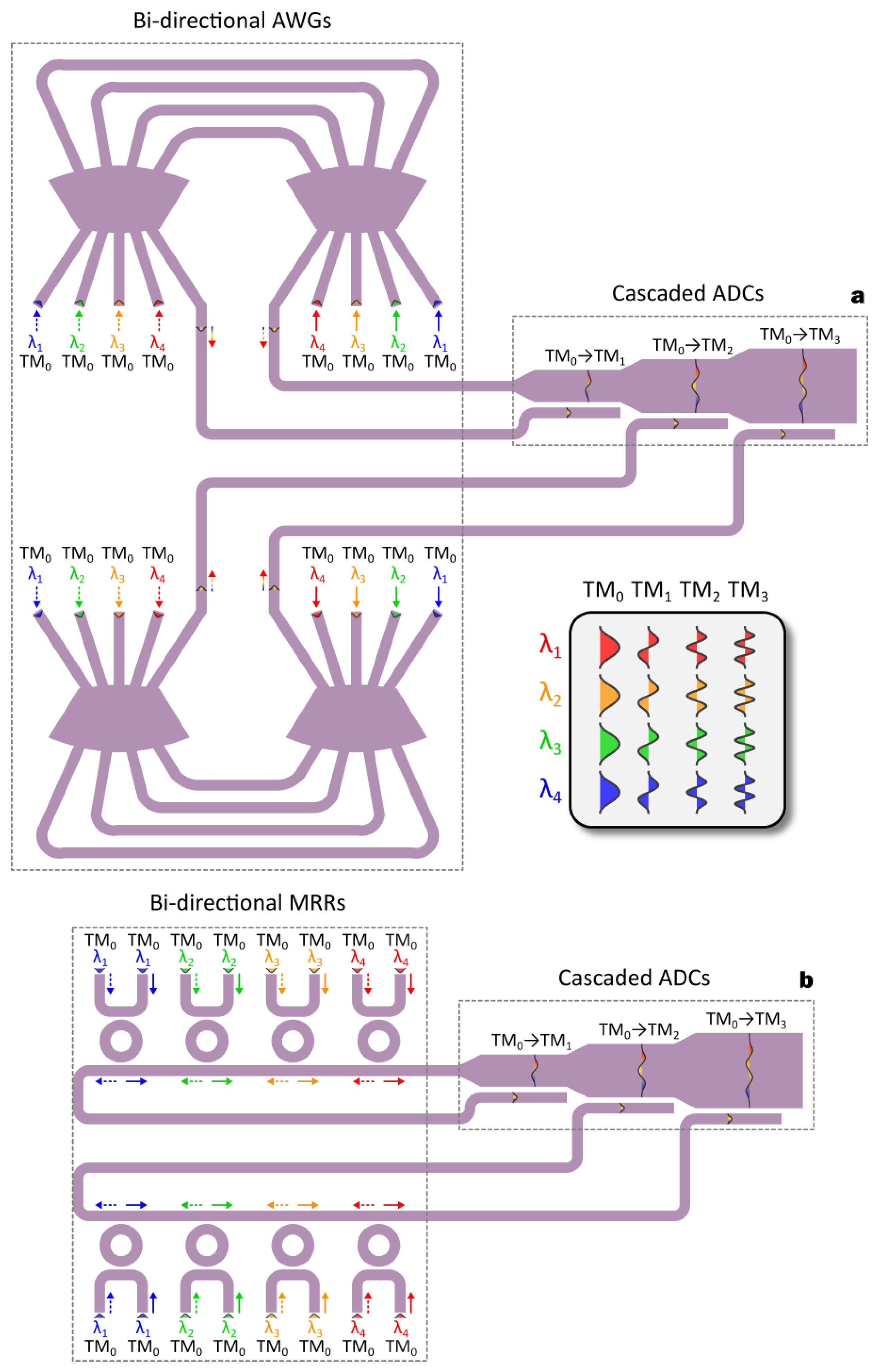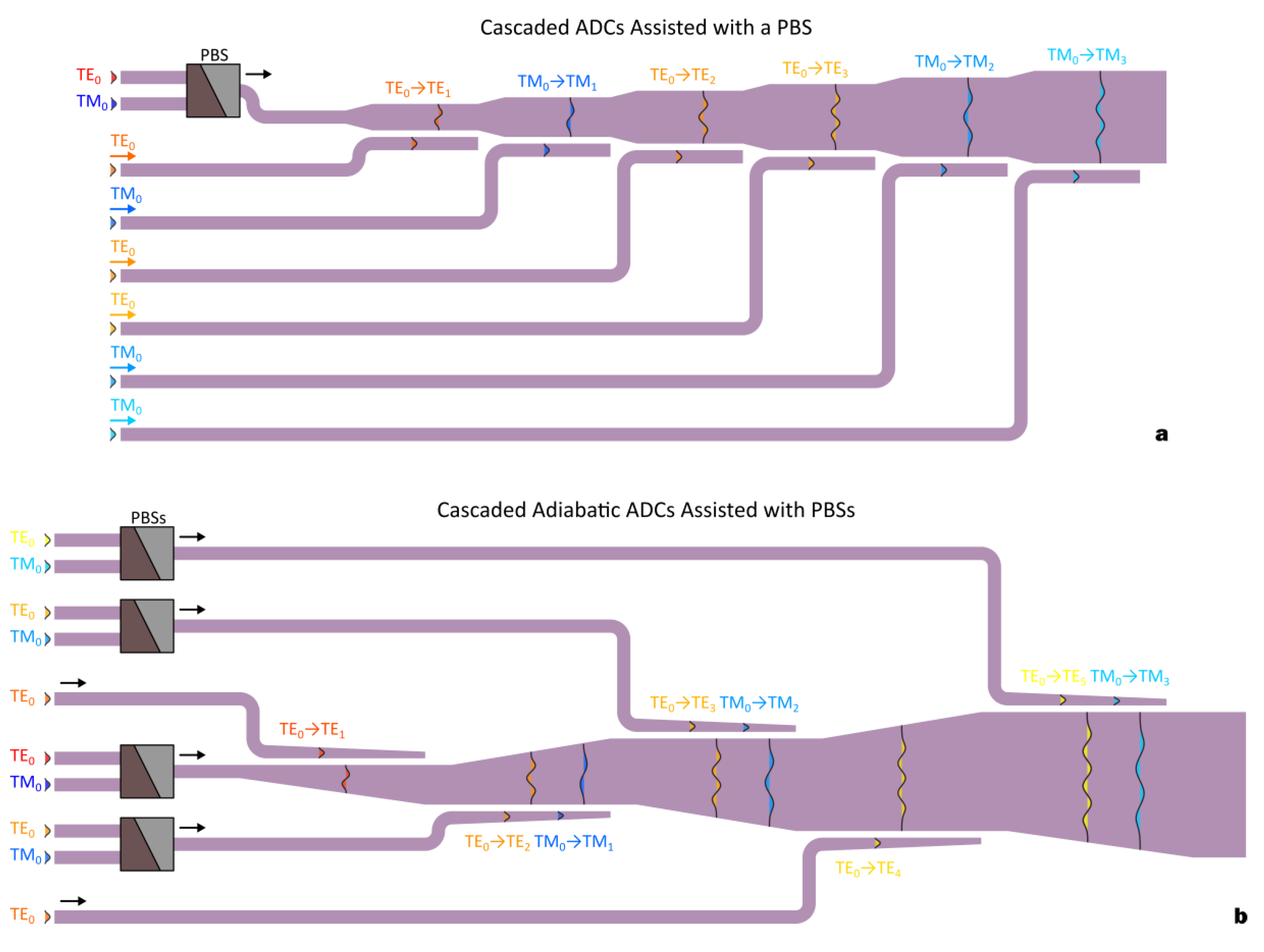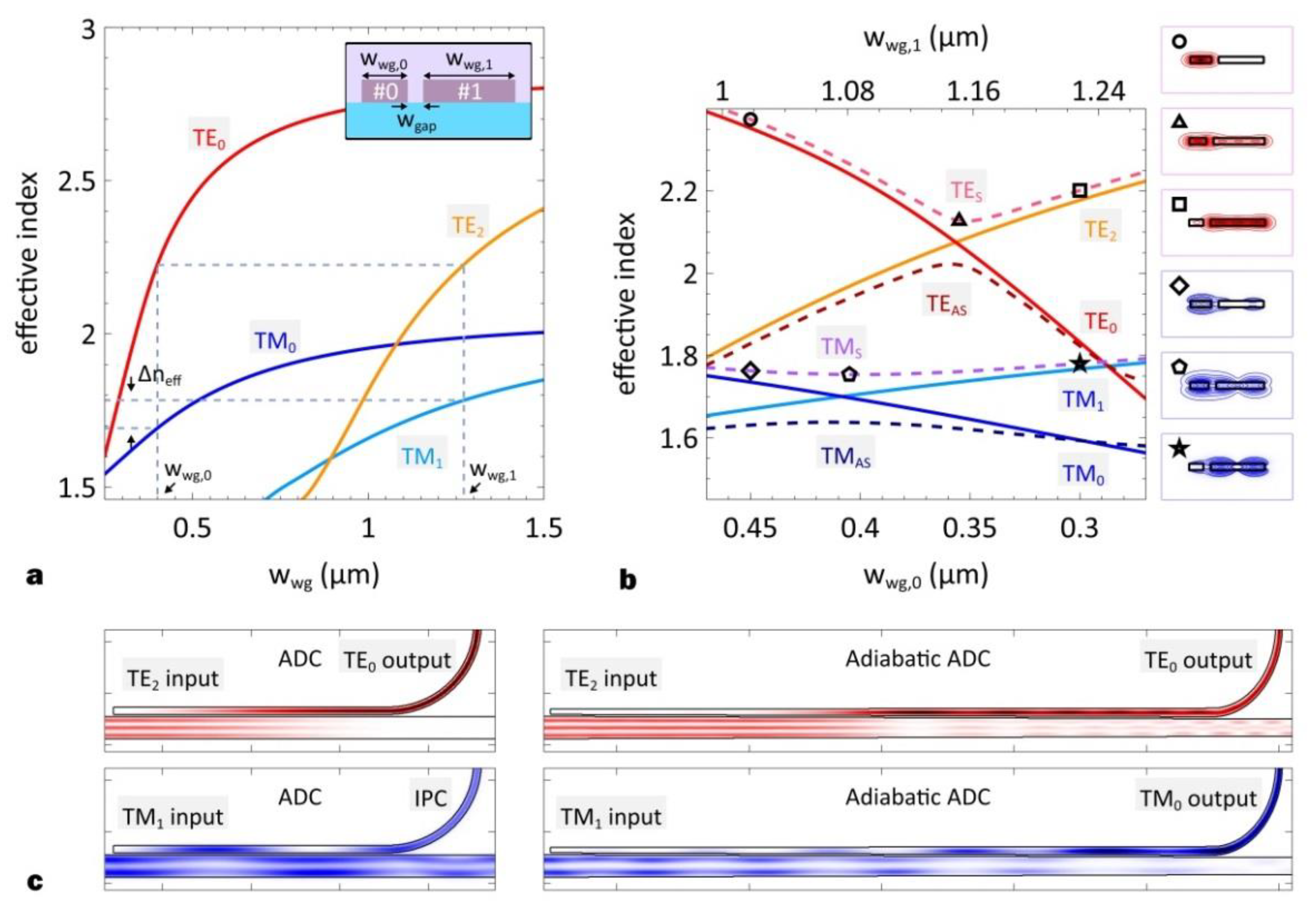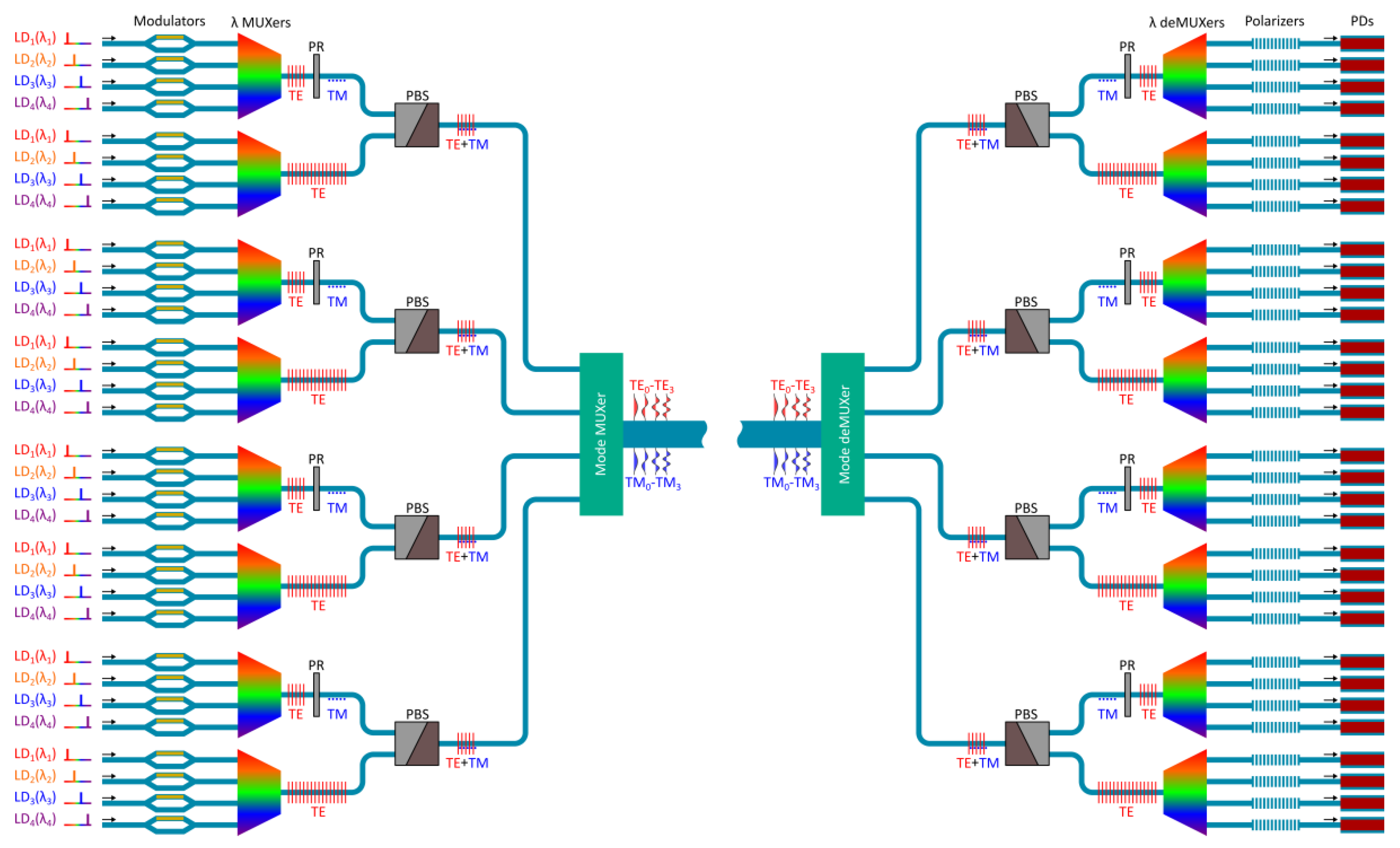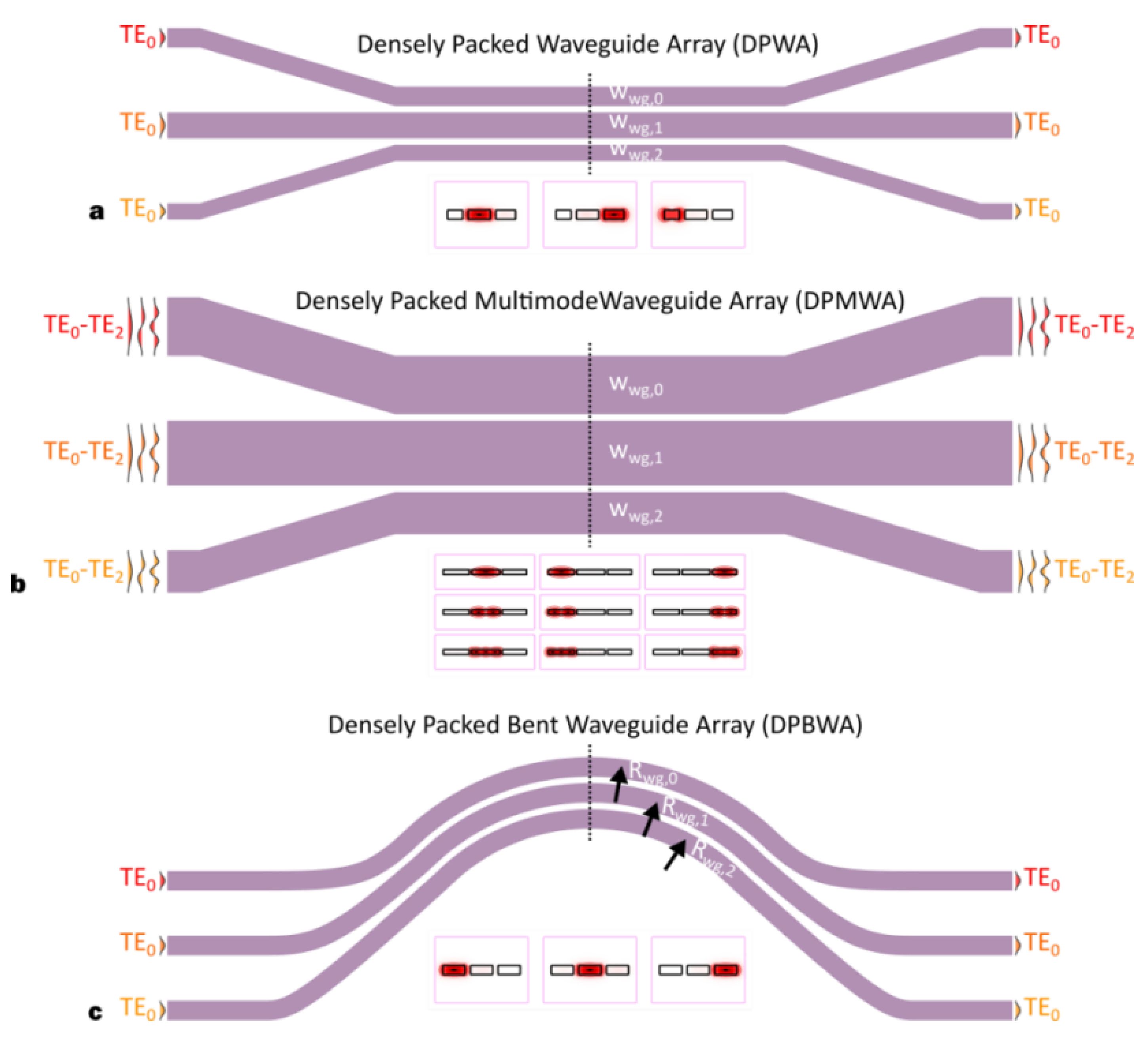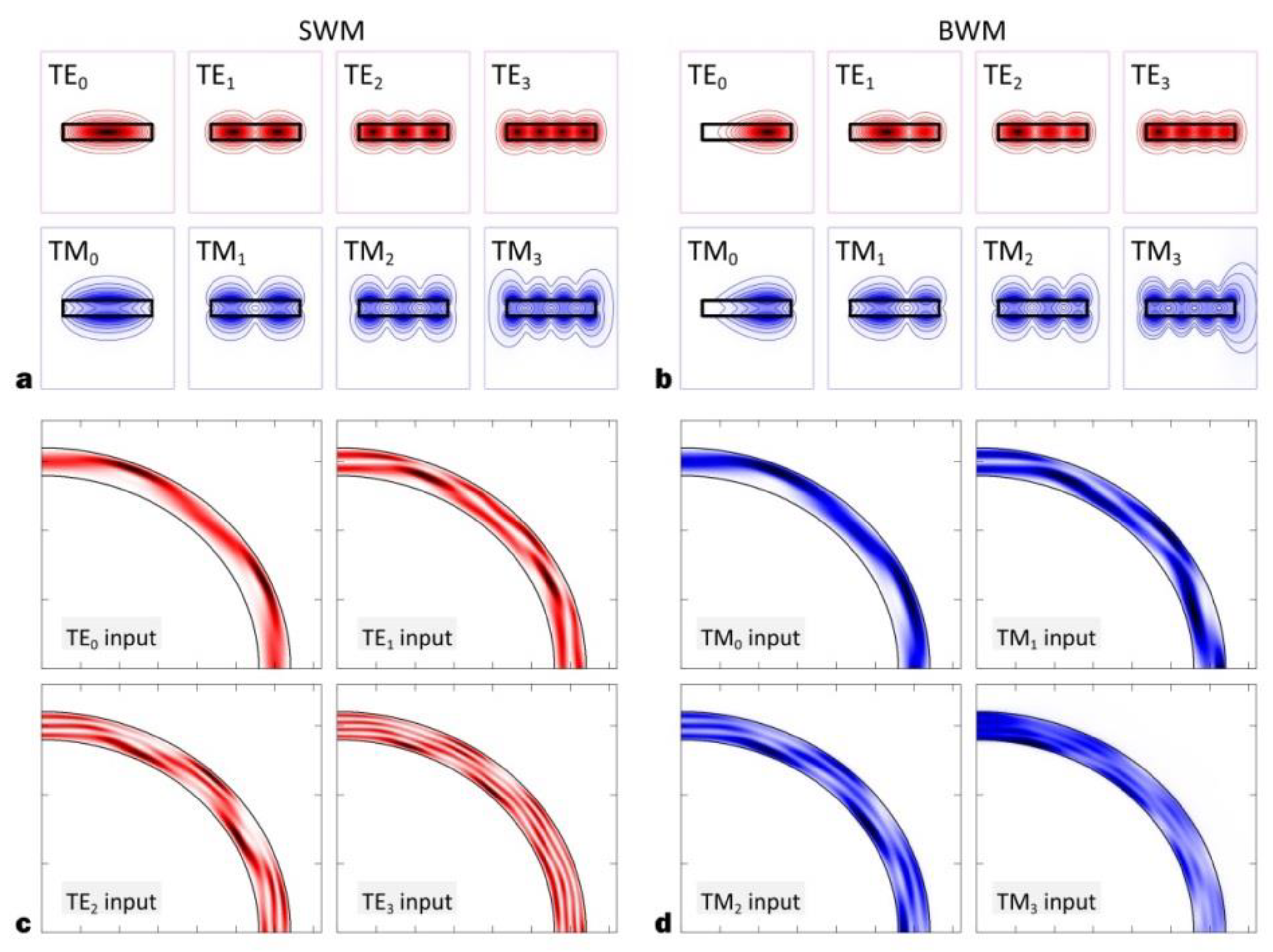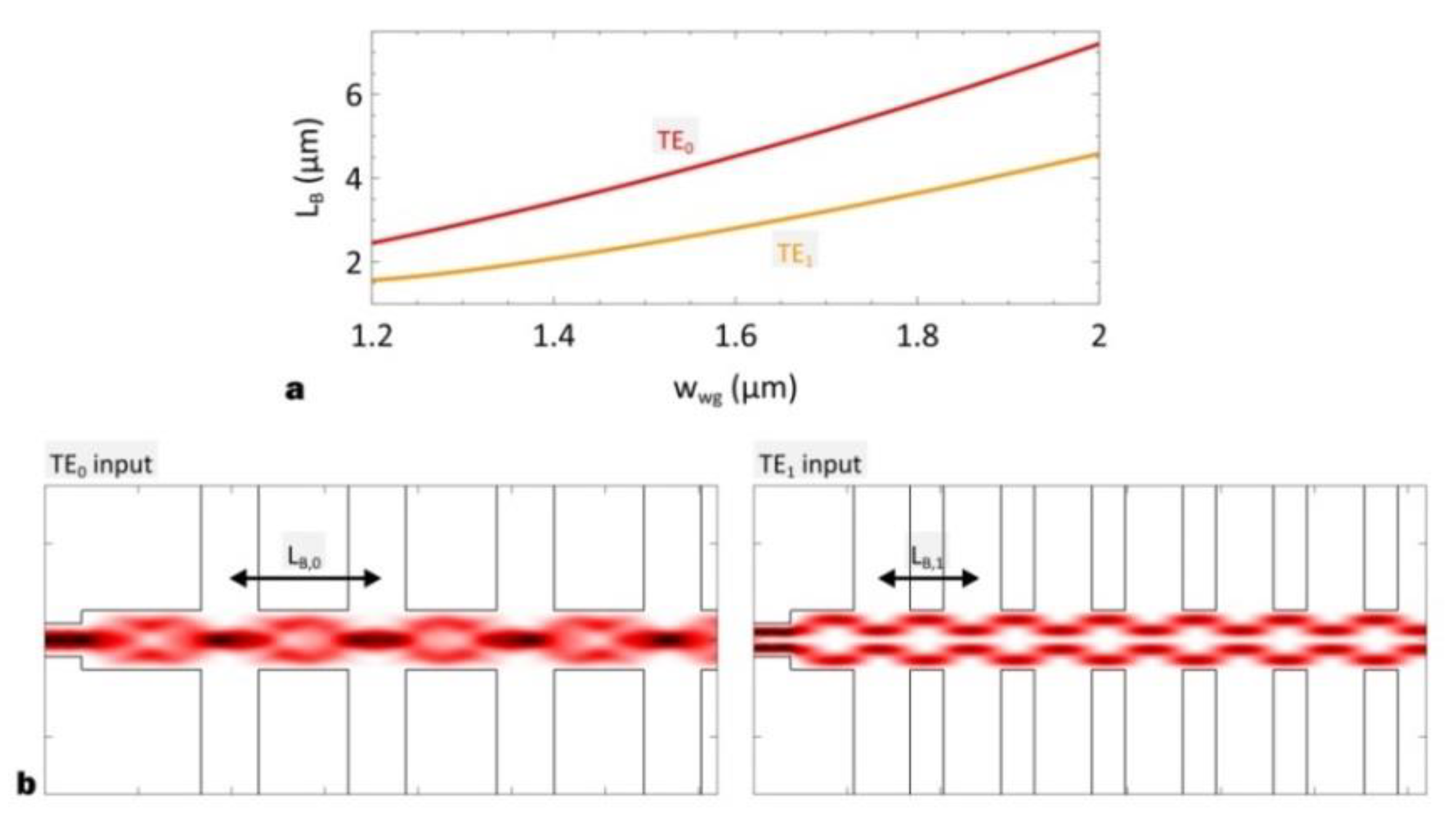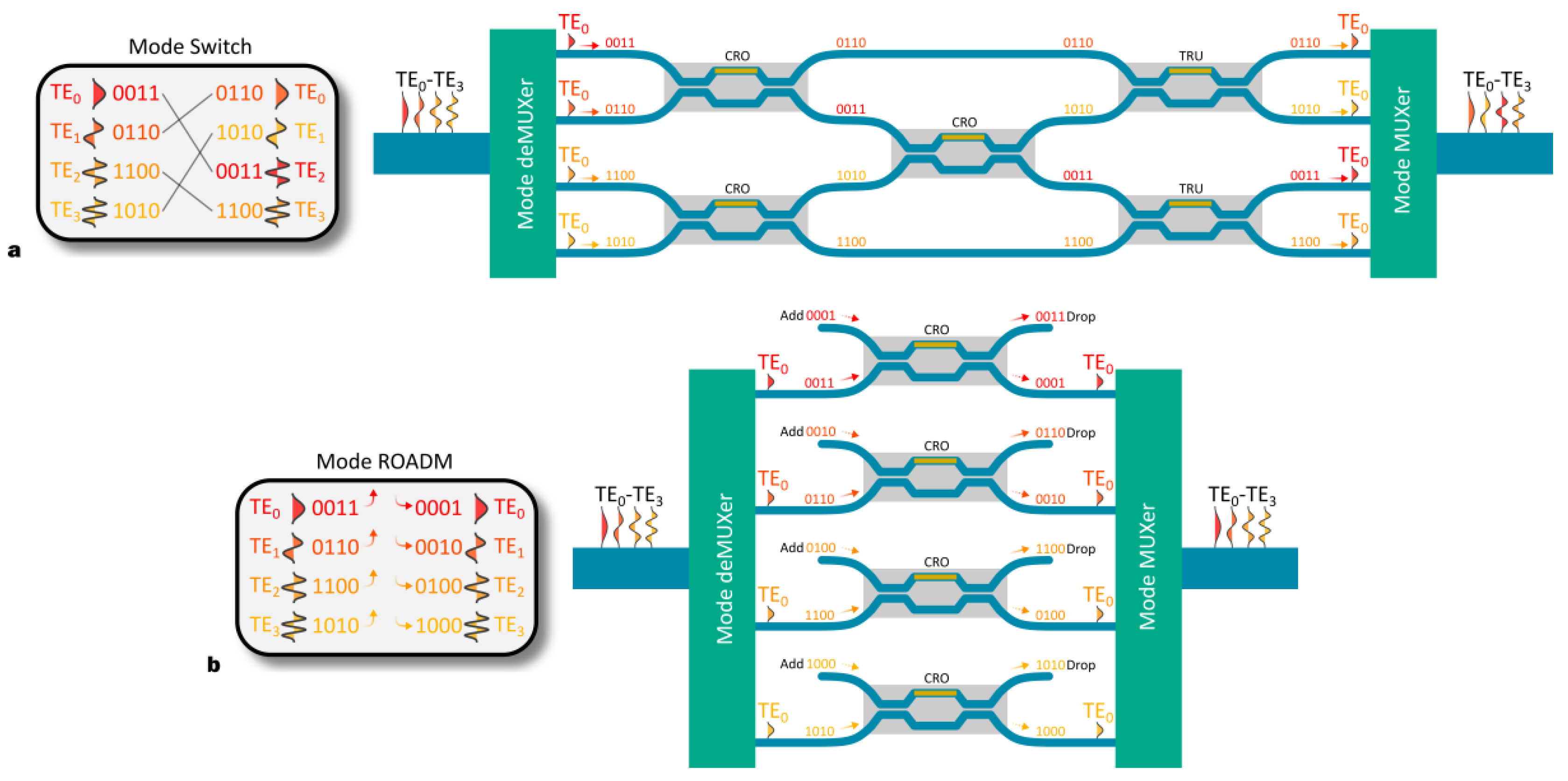2.1. Silicon Mode (De)Multiplexers
The mode (de)multiplexer enables mode conversion and signal (de)multiplexing. Such functionalities can be achieved by various different structures, e.g., multimode interference couplers (MMIs) [
23,
24,
25,
26,
27,
28], asymmetric Y-junctions [
29,
30,
31] and asymmetric directional couplers (ADCs) [
32,
33,
34,
35,
36,
37,
38,
39,
40,
41,
42,
43,
44,
45], as summarized in
Figure 3.
The MMI is formed by an interference section and several input/output waveguides [
46,
47,
48,
49,
50,
51,
52,
53,
54,
55]. The multi-mode interference can be excited by the incident light from the input port, leading to a series of self-images in the interference section [
46]. The phase and modal distributions of the output field can be tailored at each output port by appropriately choosing the MMI length/width [
56,
57,
58,
59]. For example, the input even and odd modes can be separated into different output ports when the MMI length is set to L
MMI = 3L
π/4. In this way, the MMI can serve as a mode sorter [
23]. Here, L
π can be derived as [
46]:
where n
eff,0 is the effective index for the fundamental mode, n
eff,1 is the effective index for the first higher-order mode, n
s is the slab effective index, w
eff is the effective MMI width, λ is the working wavelength. This novel property enables a novel design of four-channel mode (de)multiplexer by cascading numerous MMI-based mode sorters and phase shifters [
23]. However, for such a design, the output signal is not carried by the fundamental mode when the TE
2 mode is demultiplexed from the multi-mode bus waveguide, which hinders the further applications. In [
24], a two-channel mode (de)multiplexer was proposed by combining a 3-dB MMI coupler (L
MMI = 3L
π/2) with a MMI-based mode sorter (L
MMI = 3L
π/4), as shown in
Figure 3a. The input TM
0 mode from the edge port can be evenly split by a 3-dB coupler. The phase inversion is then introduced to the split beams by utilizing a π phase shifter. Finally, the two beams are combined by a cascaded mode sorter. The TM
0-TM
1 conversion is also carried out in the meantime. On the other hand, the input TM
0 mode from the central port can directly propagate through the 3-dB coupler and mode sorter without mode conversion. This MMI-based structure can provide low insertion losses (IL < 1.8 dB), low crosstalk (XT < −20 dB) and a broad working bandwidth (BW > 60 nm) [
25]. The major disadvantage is the relatively large device size (≈80 μm), which can be reduced by replacing the phase shifter with a tilted joint section [
26]. The two-channel mode (de)multiplexer can also be realized by using a 2 × 2 MMI coupler (L
MMI = L
π/2) assisted with a symmetric Y-junction [
27]. The designed 2 × 2 MMI coupler can evenly separate the input TE
0 mode with a phase difference of −π/2 or +π/2, which can be modified to 0 or π by inserting a π/2 phase shifter. The two beams with 0/π phase difference are then combined and converted to TE
0/TE
1 modes by a symmetric Y-junction. The simulation results show low losses (IL < 0.1 dB), low crosstalk (XT < −17 dB) and a broad bandwidth (BW > 100 nm). Compared with the previous MMI-based structures, this improved design can provide a simplified configuration as well as a better performance. However, the MMI/Y-junction structure still suffers from a relatively large footprint (≈50 μm). The device size can be effectively reduced to ≈36 μm by using a subwavelength grating (SWG) metamaterial slab with engineered refractive index and mode dispersion [
28]. Apart from the smaller footprint, this SWG-based structure also has a superior performance compared with the aforementioned MMI-based design. The working bandwidth can be as large as 300 nm, while low losses (IL < 0.84 dB) and low crosstalk (XT < −20 dB) can also be maintained.
The second type of silicon mode (de)multiplexer is based on the asymmetric Y-junction. The mostly commonly used Y-junctions are symmetric [
60,
61,
62,
63], which have been extensively applied for power splitting/combining and signal broadcasting. The asymmetric Y-junction is less common, which is usually characterized by the non-identical arms in term of the waveguide width. For the asymmetric Y-junction, the incident light from a single arm will be coupled into a higher-order mode with the closest effective index [
64]. The mode conversion factor (MCF) can be used to determine the structural parameters of an asymmetric Y-junction [
65]:
where β
a/β
b is the propagation constant for the fundamental mode in the wider/narrower arm, θ
d is the divergence angle, k
0 is the free-space wavenumber, n
c is the cladding refractive index. The mode-selective coupling occurs when MCF > 0.43 [
65]. This unique characteristic of asymmetric coupling offers a great opportunity for mode (de)multiplexing. The asymmetric Y-junctions are initially studied on low-contrast material platforms, e.g., silica waveguide or silica fiber [
64,
66,
67]. In [
29], a two-channel silicon mode (de)multiplexer was demonstrated based on asymmetric Y-junctions, as shown in
Figure 3b. For such a design, the input TM
0 mode in the wider/narrower arm excites the first even/odd mode in the “stem”, i.e., TM
0/TM
1. The measurement results exhibit low losses (IL < 1.5 dB) and low crosstalk (XT < −30dB) for the fabricated asymmetric Y-junction. However, this Y-junction-based design is quite sensitive to the structural parameters, especially to the divergence angle (θ
d), since the mode-selective condition (MCF > 0.43) will no longer be satisfied when θ
d is changed. Another drawback is the relatively narrow working bandwidth caused by the coupling-induced interference between two arms. These problems could be solved by introducing the novel shortcut-to-adiabaticity (STA) method [
68]. The parametric sensitivity and interference effect can be dramatically inhibited for the asymmetric Y-junction by varying waveguide widths and waveguide separation along the arm section [
69], leading to a robust and broadband mode (de)multiplexing. As an alternative, the two-channel mode multiplexer can also be realized by exploiting a “two-step” strategy [
30]. The TE
0 mode in the wide/narrow arm is first converted to the symmetric/asymmetric super-mode (i.e., TE
S/TE
AS) by using an adiabatic coupler [
70,
71]. Such TE
S/TE
AS super-modes are then injected into the “stem”, which will directly excite TE
0/TE
1 modes in the multi-mode bus waveguide. Here, the super-modes are used as a transition between the input fundamental modes and the output higher-order modes, which prevents the undesired crosstalk caused by direct mode conversion. The mode (de)multiplexer with low losses (IL < 1 dB) and low crosstalk (XT < −20 dB) was experimentally achieved over a broad wavelength span from 1.525 μm to 1.60 μm (BW ≈ 75 nm). Moreover, for this design, the high-performance can be preserved even if the structural parameters are deviated over a >±30 nm range. There are also some other types of Y-junction-based MDMs, such as ones based on partially etched slab waveguides [
31].
However, there are some clear disadvantages of the silicon mode (de)multiplexers based on MMIs or asymmetric Y-junctions. For instance, the MMI-based structures usually suffer from intrinsically high insertion losses due to the strong scattering at the input/output port, while for the Y-junction-based structures, a small feature size is usually required at the position where two arms are converged. The ADC has been widely considered as a better choice for realizing high-performance silicon mode (de)multiplexers, which is comprised of two closely placed waveguides with different core widths (see
Figure 4c). Here, we show a design example for an ADC-based two-channel mode (de)multiplexer considering the first two TE modes (i.e., TE
0/TE
1). The input TE
0 mode in waveguide #0 can be coupled to the output TE
1 mode in waveguide #1 through evanescent coupling (see the inset of
Figure 4a). The complete TE
0–TE
1 coupling can be obtained only if the phase-matching and critical coupling conditions are simultaneously satisfied [
72].
Figure 4a shows the calculated effective indices for TE
0 and TE
1 modes in a SOI waveguide with core width varying from 250 nm to 1 μm. Here, we consider the 220-nm-thick SOI platform with a SiO
2 upper cladding. The core width is chosen to be w
wg,0 = 400 nm for waveguide #0 to fulfill the single-mode condition operating at 1.55-μm wavelength. Thus, one can easily determine the core width for waveguide #1 as w
wg,1 = 835 nm, so that the effective indices are matched between TE
0 and TE
1 (see the dashed lines in
Figure 4a). After that, we calculate the TE
0–TE
1 coupling ratio with varied coupling length, as shown in the left panel of
Figure 4c. Here, the gap width is chosen to be w
gap = 200 nm. It can be observed that the curve is sinusoid-like and the first critical coupling length is ≈18 μm. The light propagation profile is then calculated for the optimized ADC, as shown in the left panel of
Figure 4d. From the profile, one can observe the efficient TE
0–TE
1 mode conversion and the complete power transfer from waveguide #0 to waveguide #1. Additionally, the phase-matching condition is satisfied only between TE
0 in waveguide #0 and TE
1 in waveguide #1, so TE
0 mode can directly inject into waveguide #1 without evanescent coupling or mode conversion (see the dashed lines in
Figure 4a), enabling a dual-mode (de)multiplexing.
However, for the silicon ADCs, the phase-matching and critical coupling conditions can be perfectly fulfilled only at the central wavelength due to the strong waveguide dispersion, leading to a restricted working bandwidth. The bandwidth could be expanded by using SWGs [
32,
33,
34] or hybrid plasmonics [
35], but these structures are not easy to realize. Furthermore, a stringent fabrication is always required for ADCs since the mode conversion and light-coupling processes are quite sensitive to the parametric deviations, which could significantly increase the crosstalk [
73]. These obstacles can be tackled by utilizing adiabatic ADCs [
36,
37]. The idea is to introduce an adiabatic mode evolution by gradually changing the core widths (w
wg,0, w
wg,1) along the coupling section. Here, we show a design example for an adiabatic TE
0–TE
1 ADC with linearly varied core widths. For waveguide #0, the core width is linearly varied from w
wg,0 = 350 nm to w
wg,0 = 270 nm, while for waveguide #1, the core width is linearly varied from w
wg,1 = 630 nm to w
wg,1 = 810 nm. Here, the gap width is set to be w
gap = 200 nm.
Figure 4b shows the calculated effective indices for TE
0/TE
1 modes in waveguide #0/#1 (see the solid lines) and TE
S/TE
AS super-modes in the dual-core ADC (see the dashed lines). From the curves, one can find a critical point where the effective indices are matched between TE
0 and TE
1 (w
c,0 = 325 nm, w
c,1 = 690 nm). The TE
S effective index approaches the TE
0 effective index when w
wg,0 > w
c,0 and w
wg,1 < w
c,1, indicating that the light power is mainly supported by the TE
0 mode in waveguide #0, as shown in the inset of
Figure 4b. Around the critical point, both TE
0 and TE
1 modes will be excited in waveguide #0/#1 (see the inset of
Figure 4b), indicating the phase matching. The TE
S effective index approaches the TE
1 effective index when w
wg,0 < w
c,0 and w
wg,1 > w
c,1, indicating that the light power is mainly supported by TE
1 mode in waveguide #1, as shown in the inset of
Figure 4b. Thus, the input TE
0 mode in waveguide #0 can be gradually “pushed” into waveguide #1 by slowly varying the core widths. The TE
0–TE
1 mode conversion is also attained in the meantime. To demonstrate this, we calculate the TE
0–TE
1 coupling ratio with various coupling lengths, as shown in the right panel of
Figure 4c. For the conventional ADC, the coupling ratio periodically changes with the coupling length, while for the adiabatic ADC, the coupling ratio monotonically reaches 100% when the coupling length is long enough (>100 μm), indicating that the mode conversion is an adiabatic process. One might find some ripples in the coupling–ratio curve, which is mainly induced by the slight interference effect. The light propagation profile is then calculated for the optimized adiabatic ADC, as shown in the right panel of
Figure 4d. The complete mode conversion can be observed from the calculated profile. In [
38], the silicon adiabatic ADC was demonstrated for the first time. The measurement results show low losses (IL < 0.3 dB) and low crosstalk (XT < −16 dB) over a 100-nm wavelength band. The counter-tapered ADC was proposed and demonstrated in [
39] to further enhance the working bandwidth (BW >180 nm) and relax the fabrication stringency. Later, the taper-etched ADC was proposed as a highly efficient mode (de)multiplexer [
40]. Low losses (IL < 1.3 dB) and low crosstalk (XT < −26 dB) were also experimentally demonstrated. However, adiabatic coupling is always accompanied with a long coupling length (see
Figure 4c) and a large footprint. Note that the gap width is fixed for the aforementioned ADCs, so the coupling strength is a constant for these structures. The recent studies have shown that a broad bandwidth can be ensured even with quite a short coupling length by simultaneously changing core width (w
wg,0, w
wg,1) and gap width (w
gap) [
41]. In [
42], a short and robust silicon ADC was realized by utilizing the novel STA method. A detailed description of an STA-based coupler can be found in [
74]. For this optimal design, the coupling length is as short as 50 μm, while ultra-low crosstalk (XT < −30 dB), ultra-broad bandwidth (BW > 150 nm) and ultra-large fabrication tolerance (±50 nm) can still be ensured.
From the above discussions, the structures based on MMIs, asymmetric Y-junctions and ADCs all show some degrees of advantages in achieving mode (de)multiplexing. However, all these mode (de)multiplexers are not scalable, which means that these designs can only support a few modes (typically two modes). The scalable mode (de)multiplexers are desired in the MDM systems, which can be built by successively connecting several Y-junctions [
75,
76] or ADCs [
77,
78,
79,
80,
81,
82].
Figure 5a shows the configuration of a typical four-channel mode (de)multiplexer using the cascaded asymmetric Y-junctions [
75]. Three higher-order TE modes (i.e., TE
1, TE
2, TE
3) can be independently excited by several different Y-junctions, while the fundamental TE mode, i.e., TE
0, is directly injected into the multi-mode bus waveguide. The arm widths are carefully chosen so that the mode-selective condition is satisfied for only one higher-order mode in each Y-junction. In [
76], W. Chen et al. reported a three-channel MDM with cascaded asymmetric Y-junctions on silicon. The experimental results exhibit crosstalk of XT ≈ −10 dB for the first three TE modes (i.e., TE
0–2). Nevertheless, the cascaded asymmetric Y-junction still seriously suffers from significant insertion losses (IL > 5 dB) and the small feature size at the junction’s tip. In contrast, the cascaded ADCs are broadly considered as a more promising candidate for mode (de)multiplexing based on the best overall performances. In 2013, the first cascaded ADC-based silicon mode (de)multiplexer was reported by D. Dai et al. [
77], as illustrated in
Figure 5b. In ADC #i, the phase matching is satisfied only between TM
0 and TM
i, so the input TM
0 mode can converted to TM
i mode and multiplexed into the multi-mode bus waveguide, while the other higher-order modes (i.e., TM
j, j < i) will go through the coupling section with negligible losses. Additionally, TM
0 mode is directly launched from the multi-mode bus waveguide without evanescent coupling or mode conversion. In this way, a four-channel mode (de)multiplexer can be built by cascading three ADCs with adiabatic tapers as connectors in between. Compared with the cascaded Y-junctions, the proposed cascaded ADCs can provide a larger feature size (>300 nm), lower insertion losses (IL < 1 dB) and lower crosstalk (XT < −23 dB). However, the experimental results also show a relatively narrow working bandwidth (BW ≈ 20 nm), which can be further improved (BW > 100 nm) by exploiting adiabatic coupling [
39,
78,
79] or ultra-thin waveguides [
80]. Moreover, recent research also shows that the crosstalk of cascaded ADCs can also be further mitigated by exploiting coherence detection [
83]. In
Table 1, we summarize the reported silicon mode (de)multiplexers. It can be seen that the various silicon mode (de)multiplexers have been realized with low losses, low crosstalk and a broad bandwidth. In theory, the mode capacity can be expanded at will by simply cascading more ADCs; however, an extremely long coupling length would be needed to achieve the conversion to a very high-order mode, which could lead to a large and complex device layout as well as increased crosstalk. The issue could be addressed by employing SWG waveguides with an engineered index [
81,
82]. However, the fabrication of SWG is immature given its subwavelength feature size. To further expand the capacity, a more effective solution is the wavelength/polarization/mode hybrid (de)multiplexing that combines multiple dimensions of light. A discussion about silicon hybrid (de)multiplexers will be given in
Section 2.2.
2.2. Silicon Hybrid (De)Multiplexers
As discussed above, mode (de)multiplexing can efficiently enhance the link capacity, but it is still quite difficult to (de)multiplex very high-order modes in a multi-mode bus waveguide. Therefore, it is more cost effective to build multi-dimensional on-chip communication systems by combining MDM with WDM [
86,
87,
88,
89,
90,
91,
92,
93,
94,
95] and PDM [
96,
97,
98,
99,
100].
The wavelength/mode hybrid (de)multiplexers are able to simultaneously manipulate signals carried by wavelength and mode channels. WDM/MDM hybrid systems could be realized by using some special mode (de)multiplexers with strong wavelength-selectivity, e.g., asymmetric Y-junctions [
86], grating-assisted ADCs [
87], photonic crystals [
88] and asymmetric micro-ring resonators [
89,
90]. However, such wavelength-selective mode coupling is usually quite sensitive to parametric deviations, which make it difficult to align each wavelength/mode channel. A more general architecture is to cascade the broadband mode (de)multiplexers (e.g., cascaded ADCs) with the conventional wavelength (de)multiplexers, such as arrayed waveguide gratings (AWGs) [
91,
92] and micro-ring resonators (MRRs) [
94,
95], as summarized in
Figure 6.
The silicon AWGs are most commonly used in the dense wavelength division-multiplexing (DWDM) systems because of the large free-spectral range (FSR) and small channel spacing [
101,
102,
103,
104,
105,
106,
107], showing great potential for large-scale hybrid (de)mulitplexing. In [
91], a 64-channel WDM/MDM hybrid system was demonstrated on silicon by cascading four identical 16-channel AWGs with a four-channel mode (de)multiplexer. For each AWG, sixteen wavelength carriers are multiplexed into a single-mode waveguide with TM
0. These four waveguide channels are then converted to TM
0-TM
3 and multiplexed into a multi-mode bus waveguide, which makes a total link capacity of 64 (16 × 4). For such a structure, the insertion losses and crosstalk were measured to be IL≈7 dB and XT ≈ −10 dB, respectively. It should be noted that the AWGs can be bi-directional, which means that two 1 × N AWGs can be replaced by one (N + 1) × (N + 1) AWG with equivalent functionalities [
101], as shown in
Figure 6a. This idea was implemented to realize an improved wavelength/mode hybrid (de)multiplexer with an AWG number reduced to half [
92]. The measurement results show insertion losses of IL ≈ 5 dB and crosstalk of XT ≈ −14 dB for a 64-channel WDM/MDM hybrid system. Nevertheless, the device footprint is still quite large (a few millimeters) for AWG-based wavelength/mode hybrid (de)multiplexers even if bi-directional configurations are applied. As an alternative, the cascaded MRRs are also popular for WDMs because of the low insertion losses, high extinction ratios and, especially, the compact device sizes [
108,
109,
110]. Moreover, according to the tight-binding model [
111], the top-flattened transmission responses can be realized by simply cascading several side-coupled MRRs in a serial [
112]. Additionally, both clockwise and counterclockwise propagations are allowed in MRRs, so the bi-directional configurations are also applicable, as illustrated in
Figure 6b. In [
94], a 32-channel WDM/MDM hybrid system was demonstrated on silicon by cascading two sets of bi-directional eight-channel MRR arrays with a four-channel mode (de)multiplexer. For the fabricated device, the insertion losses were measured to be IL < 4.5 dB while the crosstalk was measured to be XT < −18dB. The insertion losses and crosstalk can be further reduced by adopting flat-top MRR filters [
95]. We give a summary of the reported silicon wavelength/mode hybrid (de)multiplexers in
Table 2. It can be seen that, for most of the reported structures, the wavelength channels still outnumber the mode channels, which gives rise to the system cost and layout complexity. Hence, it is necessary to reduce the wavelength channels further by introducing TE/TM polarizations as a third dimension. Furthermore, coarse wavelength-division multiplexing (CWDM) with a larger channel spacing (> 20 nm) could also be helpful to enhance the stability and lower the cost [
93,
113,
114,
115,
116,
117].
The polarization/mode hybrid (de)multiplexers are able to handle multiple mode channels with dual polarizations. One straightforward scheme is to directly cascade the two groups of ADCs designed for TE and TM modes, respectively, as illustrated in
Figure 7a. In [
96], an eight-channel polarization/mode hybrid (de)multiplexer was demonstrated on silicon with the first four TE/TM modes (i.e., TE
0–3 and TM
0–3). The higher-order modes (i.e., TE
1–3 and TM
1–3) are excited by using the cascaded ADCs, while TE
0 and TM
0 modes are coupled into the multi-mode bus waveguide by using a polarization beam splitter (PBS). The experimental results exhibit insertion losses of IL ≈ 2dB and crosstalk of XT ≈ −10 dB over a 30-nm bandwidth. For such polarization/mode hybrid (de)multiplexers, the measured crosstalk is much higher compared with the conventional mode (de)multiplexers working on a single polarization [
77]. Such a phenomenon is mainly due to the undesired inter-polarization crosstalk (IPC) at the receiver terminal. Here, we show a design example to illustrate this effect. We calculate the effective indices for TE
0 and TE
2 modes in the 220-nm-thick SOI with SiO
2 cladding, as shown in
Figure 8a. The waveguide widths are chosen to be w
wg,0 = 400 nm and w
wg,1 = 1.27 μm to meet the phase-matching condition between TE
0 and TE
2 at a 1.55-μm wavelength. The gap width is chosen to be w
gap = 150 nm. The coupling length is then optimized to be 15.5 μm to achieve critical coupling. Thus, the input TE
2 mode can be completely demultiplexed from the multi-mode bus waveguide with negligible residual power, as shown in
Figure 8c. Unfortunately, for these optimal parameters, the effective indices are also quite close between TM
0 and TM
1 (see the dashed lines in
Figure 8a). As a result, part of the input TM
1 mode will also be extracted by the ADC optimized for TE
0–TE
2 conversion (see
Figure 8c), leading to the significant IPC. The IPC could be reduced by optimizing the structural parameters to achieve a polarization-selective mode coupling [
96,
97,
98]. However, this methodology always leads to a relatively narrow working bandwidth and a significant parametric sensitivity. Another possible solution is to cascade the polarizers to filter out the undesired polarizations [
99], but polarization filtering will give rise to the total insertion losses [
118,
119,
120,
121,
122,
123,
124,
125,
126,
127,
128].
The IPC problem can be addressed by exploiting the cascaded adiabatic ADCs, as shown in
Figure 7b. The idea is to optimally choose the core widths for each ADC, so that both TE and TM polarizations can be completely extracted from the multi-mode bus waveguide. The decoupled TE
0 and TM
0 modes are then separated by a PBS. To illustrate this idea, we show a design example of adiabatic ADC considering both TE
0–TE
2 and TM
0-TM
1 mode conversions. For waveguide #0, the core width is linearly varied from w
wg,0 = 270 nm to w
wg,0 = 470 nm, while for waveguide #1, the core width is linearly varied from w
wg,1 = 1.27 μm to w
wg,1 = 990 nm. Here, the gap width is set to be w
gap = 150 nm.
Figure 8b shows the calculated effective indices for TE
0/TE
2/TM
0/TM
1 modes (see the solid lines) and TE
S/TE
AS/TM
S/TM
AS super-modes (see the dashed lines). Over this width variation range, the phase matching can be achieved for both TE
0–TE
2 and TM
0-TM
1 at different critical widths (see the curve intersections in
Figure 8b). Thus, the input TE
2 and TM
1 modes can be simultaneously “pushed” into the single-mode waveguide (see the inset of
Figure 8b). We then calculate the light propagation profiles for the optimized ADC when TE
2 and TM
1 modes are launched, as shown in the right panel of
Figure 8c. Here, the coupling length is chosen to be 50 μm to satisfy the adiabatic condition. From the profiles, one can observe the efficient mode conversion and complete power transfer for both TE and TM polarizations. This idea was implemented to realize a 10-channel polarization/mode hybrid (de)multiplexer working with the first six TE and four TM modes (i.e., TE
0–5, TM
0–3). The experimental results show low losses (IL < 1.8 dB) and low crosstalk (XT < −15 dB) over a 90-nm wavelength band. In
Table 3, we summarize the reported silicon polarization/mode hybrid (de)multiplexers. One can see that the link capacity can be efficiently enhanced (up to 10 channels) by combining MDM and PDM technologies, while low losses (IL < 2 dB) and low crosstalk (XT ≈ −20 dB) can still the preserved over quite a broad wavelength band (BW ≈ 100 nm).
The link capacity can be dramatically scaled up by employing WDM/MDM or PDM/MDM hybrid systems. However, it is still challenging to realize WDM/PDM/MDM hybrid systems that involve all the three dimensions of light. So far, there have been only a few demonstrations on the wavelength/polarization/mode hybrid (de)multiplexing. Recently, Y. He et al. demonstrated an eight-channel hybrid (de)multiplexer with two wavelengths, two polarizations and two modes [
129]. The device is based on the cascaded contra-directional couplers that assist with Bragg gratings. According to the Bragg condition, each coupling section can select a single carrier on a specific wavelength/polarization/mode channel. Nevertheless, the capacity is still restricted for this structure, and the insertion losses are also quite significant (IL ≈ 6.6 dB). Here, we propose a general configuration for the scalable WDM/PDM/MDM hybrid systems, as illustrated in
Figure 9. As an example, we show a 32-channel hybrid (de)multiplexer with four wavelengths, two polarizations and four modes. At the transmitter terminal, the 32-channel carriers with TE
0 are firstly coupled into eight single-mode waveguides in term of the wavelengths. Four of them are cascaded with the broadband polarization rotators [
130,
131,
132,
133,
134,
135,
136,
137,
138,
139,
140,
141] that convert TE
0 to TM
0. The PBSs [
142,
143,
144,
145,
146,
147,
148,
149,
150,
151,
152,
153] are then utilized to combine the orthogonal polarizations, so that the 32-channel signals can be carried by four single-mode waveguides. Finally, all the carriers are coupled into a multi-mode bus waveguide by using a polarization/mode hybrid multiplexer working on TE
0–3 and TM
0–3 [
100]. At the receiver terminal, the 32-channel carriers are decoupled from the multi-mode bus waveguide by cascading MDM, PDM and WDM in sequence. This configuration can be used as a general architecture to build any user-defined WDM/PDM/MDM hybrid system.
2.3. Densely Packed Waveguide Array
For the MDM system, the signals are usually carried by multiple higher-order modes in a wide multi-mode bus waveguide. However, from the above discussions, one might find that the high-performance mode (de)multiplexers are not easily realized. Instead of using the higher-order modes, the MDM can also be obtained by using the super-modes supported by several closely placed single-mode waveguides, leading to the novel concept of a densely packed waveguide array (DPWA) [
154,
155,
156,
157,
158,
159,
160], as shown in
Figure 10.
In [
154], the DPWA-based MDM was proposed for the first time. The structure consists of three single-mode SOI waveguides each with different core widths and narrow gap widths in between, as shown in
Figure 10a. Three super-modes can be supported by the DPWA. Unlike the conventional guided modes that are supported by a single isolated waveguide, the super-modes are supported by an array of waveguides, so the field contribution can be engineered by modifying parameters for each waveguide. If the core widths are uniform (w
wg,0 = w
wg,1 = w
wg,2), each super-mode will have power distributions in more than one waveguide. In contrast, if the core widths are non-uniform (w
wg,0 ≠ w
wg,1 ≠ w
wg,2), each super-mode will be well confined in a single core region due to phase mismatching (see the inset of
Figure 10a). Moreover, such distinguishable distribution can be kept for all the three super-modes even if the gap widths are deep-subwavelength (w
gap = 100 nm), so the waveguide array can be regarded as a multi-mode bus waveguide with a small lateral-dimension. For DPWA, mode (de)multiplexing can be achieved by using a simple fan-in/out structure since the mode profiles are perfectly matched between super-modes and individual TE
0 mode, leading to a simple device layout. Such DWPA-based MDM can provide low losses (IL < 0.1 dB), low crosstalk (XT < −20dB) and a broad bandwidth (BW >100 nm). Furthermore, the DPWA can also be used as a sub-cell in an even larger waveguide super-lattice structure [
155,
156].
For DPWA-based MDM, the total capacity can be expanded further by introducing dual polarizations or higher-order modes [
157,
158]. In [
157], a five-channel polarization/mode hybrid multiplexing was demonstrated with a DPWA supporting three TE super-modes and two TM super-modes. The fabricated device exhibits low losses (IL < 0.6 dB) and low crosstalk (XT < −15 dB) over an 80-nm wavelength span. However, the scalability is limited for this design since there are only two orthogonal polarizations. The densely packed multi-mode waveguide array (DPMWA) was proposed to break the limit [
158]. The DPMWA structure is comprised of three parallel multi-mode waveguides each supporting three TE modes (i.e., TE
0–2), leading to a transmission capacity of nine super-modes, as shown in
Figure 10b. Each super-mode can be effectively restricted within a single core region (see the inset of
Figure 10b) because of the core width differences. To realize the mode multiplexing, the higher-order modes are firstly excited in each waveguide by using the cascaded ADCs; the excited higher-order modes can directly convert to the corresponding super-modes through a simple butt-coupling process. From the experimental results, one can find low losses (IL < 1 dB) and low crosstalk (XT < −15 dB).
For DPWA, large effective-index difference is always desired between the adjacent cores in order to reduce the crosstalk in the MDM system. Phase mismatching can be achieved by changing the core widths, as discussed above. However, the width variation design requires a high-resolution fabrication process. An alternative is to engineer the waveguide curvature. For the bent waveguides, the phase-matching condition can be written as [
161]:
where n
eff,0 and n
eff,1 are the effective indices, R
0 and R
1 is the bending radii. From the equation, it can be seen that the adjacent cores can be phase-mismatched even with the same core widths (n
eff,0 = n
eff,1) as long as the bending radii are different (R
0 ≠ R
1), which leads to the densely packed bent-waveguide array (DPBWA), as shown in
Figure 10c. In [
159], a 16-channel DPBWA-based MDM was demonstrated with low losses (IL < 1 dB), low crosstalk (XT < −20 dB) and a broad bandwidth (BW > 80 nm). All the waveguides in the proposed DPBWA have the same core widths, which makes the DPBWA quite easy to fabricate. In [
160], a similar super-lattice structure was also demonstrated with low losses (IL < 0.5 dB) and low crosstalk (XT < −19.5).
The working performances for the reported silicon DPWAs are summarized in
Table 4. One can see that the major advantage of the DPWA/DPMWA/DPBWA-based MDM is the large capacity (up to 16 channels) since the channel number can be easily scaled up by involving more waveguides. The losses and crosstalk are also quite weak due to the convenient mode (de)multiplexing. We believe that the novel DPWA can offer great opportunities for high-density on-chip optical transmissions.
